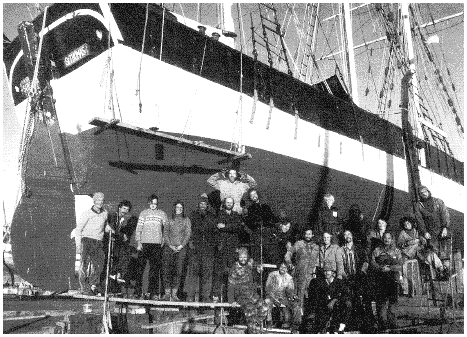Horizon:
The Restless Journey and
Tragic Sinking of
A Tall Ship
Pamela Sisman Bitterman
(Terrace/University of Wisconsin)

- The Sofia may best be characterized by what she does not possess: satellite navigation systems, Loran, WeatherFax, anemometer, winches, electric windlass, auto pilot, depth sounder, propane, inboard 110-volt electrical system, private staterooms, hot water --- heck, running water at all.
For most of our journey, battling through doldrums, dysentery, Dengue fever, hurricanes, ship-board mutinies, port police harassment, boredom, incoherent love-affairs, Ms. Bitterman shows herself to be an incompetent, amateur writer, one who could well have benefited from the intervention of a good editor. She apparently never heard of Mark Twain's edict to murder unnecessary adjectives in their cribs or E. B. White's strictures against the passive case. She also apparently never appreciated the writers' hoariest dicta: no clichés.
Thus the hapless reader is subject to the likes of
- Before me, over Sofia's bow, which is finally unleashed and biting into the waves with a voracious hunger --- charumph! charumph! --- lies the far horizon that promises my future. It looks soft and summoning. I feel marvelously empowered and rarin' to go.
Or, "We were leaving behind the dreamy magic of the South Pacific and its complementary complacency on board ship."
- The South Seas had lulled the crew of the Sophia into a[n] euphoric sense of well-being. Amid those tranquil islands, the tall ship and her crew were kindred spirits, hull and hearts buoyed in unison, soul mates sailing along the great equatorial pathway.
"Hull and hearts buoyed in unison." Charumph, indeed.
In addition to these meaningless infelicities, Bitterman gets stuck in the doldrums of the passive case, cannot master the storms of dialogue, abandons ship when it comes to personal revelation, and sinks without a whit of humor. Despite this, she does have one good thing going for her. The final days, the revolt of the crew, and the drowning of the Sofia are of such power that they carry the story along despite her literary incompetence. The last moments of this schooner foundering in a storm near the cliffs of northern New Zealand is gripping. The Sofia here appears as a character on its own: feisty, ancient, massive.
The photograph on page 292 comes as a surprise: this sailing vessel is huge. Because of her age and construction, she seems to spend as much time in dry-dock as on her circumnavigation. Indeed, the crew's final mutiny is not over where and how to sail as much as how much time is going to be spent diddling around Nelson, New Zealand breaking in the refurbished ship before taking off for Australia.
Once one gets over the overwriting, Sailing to the Far Horizon is as good a textbook as one could find in the how-to- The final days of the Sofia give both author and reader a jolt and a touch of sadness. One of the crew is lost in the storm, as well as a coatimundi --- the ship mascot. The Lord alone knows why one would ever allow such a creature aboard a gentle sailing ship: coatis are foul-tempered, smelly beasts that favor hissing at friends and baring their ugly yellow teeth at strangers. Instead of being pampered, "Varmit" should have been shot and fried (Central and South American mountain folk savor its tangy flesh). Perhaps it, and the Sofia, should have been put out of their misery long before the final day when they went down in a rage.